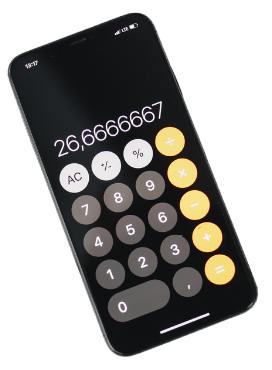Explore all NSW maths syllabus topics for Years 1–10 with clear explanations, examples, and free practice tests aligned to the NSW curriculum.
Our experienced NSW math tutors have carefully created NSW maths syllabus topics material to align perfectly with the NSW syllabus and help students excel.
Each topic includes clear explanations, step-by-step examples, and visuals to make learning maths easier and engaging.
Every topic follows the NSW Maths Syllabus (Years 1–10), ensuring students learn exactly what’s taught in Sydney schools.
Regular practice builds confidence and prepares students for NAPLAN, OC, and Selective School exams with real-style questions.
Find structured practice tests aligned to the NSW syllabus for Years 1–10. These resources make it easier for parents to track progress and support their child’s maths learning at home.
In Term 1 of Year 6 Mathematics (NSW syllabus), students study two key topics:
Fractions: Perform addition, subtraction, multiplication, and division of fractions, applying these operations to solve word problems.
Fractions & Decimals: Convert between fractions and decimals to develop fluency and strengthen connections between number representations.
In Term 2 of Year 6 Mathematics (NSW syllabus), students study three key topics:
Decimals: Order Decimals and Apply the four operations (addition, subtraction, multiplication, and division) with decimals to solve problems in everyday contexts.
Percentages: Develop an understanding of percentages, including calculating a percentage of an amount and applying percentages in practical situations.
Financial Mathematics: Explore concepts of profit and loss, and apply simple budgeting strategies to real-life financial scenarios.
In Term 3 of Year 6 Mathematics (NSW syllabus), students study four key topics:
Geometry of 2D and 3D Shapes: Investigate angle properties and apply them to solve problems involving different figures.
Triangles and Quadrilaterals: Classify and describe triangles and quadrilaterals based on their side lengths and angle properties.
Circles: Explore the features of circles, including radius, diameter, circumference, and key angle relationships.
Measurement: Calculate area, surface area, and volume for a variety of 2D and 3D shapes, applying formulas in practical contexts.
In Term 4 of Year 6 Mathematics (NSW syllabus), students study four key topics:
Cartesian Plane: Learn to plot and identify points in all four quadrants of the Cartesian plane, forming the foundation for graphing relationships.
Integers: Explore negative numbers in real-life contexts and perform computations involving addition, subtraction, multiplication, and division.
Data Analysis: Calculate and interpret mean, median, and mode, using these measures to summarise and compare datasets.
Probability: Investigate the probability of simple events using fractions and develop an understanding of key probability terminology.
In Term 1 of Year 7 Mathematics (NSW syllabus), students study three key topics:
Integers: Compare and order integers, and perform addition, subtraction, multiplication, and division with positive and negative integers, applying all four operations.
Indices: Use index notation for powers and prime factorization, and explore square and cube roots.
Linear Relationships: Plot and identify points on the Cartesian plane and graph linear relationships.
In Term 2 of Year 7 Mathematics (NSW syllabus), students study two key topics.
Algebraic Techniques: Understand pronumerals as symbols for numbers, form and evaluate algebraic expressions using substitution, apply arithmetic laws to algebraic terms, and use the distributive law to expand expressions.
Fractions, Decimals, and Percentages: Compare equivalent fractions, round decimals to a required accuracy, identify terminating and recurring decimals, convert between fractions, decimals, and percentages, recognize irrational numbers, and perform addition, subtraction, multiplication, and division with fractions and decimals.
In Term 3 of Year 7 Mathematics (NSW syllabus), students study three key topics.
Equations: Solve one- and two-step linear equations, verify solutions by substitution, and are introduced to simple quadratic equations.
Angle Relationships: Apply geometric notation and conventions, work with angles at a point, corresponding, alternate, and co-interior angles, explore angle properties in parallel lines and transversals, and solve angle problems using reasoning.
Properties of Geometric Figures: Classify triangles and quadrilaterals and apply their geometric properties.
In Term 4 of Year 7 Mathematics (NSW syllabus), students study five key topics.
Data Classification & Visualization: Classify data as numerical (discrete or continuous) or categorical (nominal or ordinal) and represent data using graphs and charts.
Data Analysis: Calculate mean, median, mode, and range.
Length & Circles: Calculate the perimeter of quadrilaterals and composite shapes, and explore circle properties and features.
Area: Develop and apply formulas for the area of rectangles, triangles, and parallelograms, and calculate the area of circles and sectors.
Probability: Determine probabilities of chance experiments and complementary events.
In Term 1 of Year 8 Mathematics (NSW syllabus), students study two key topics:
Percentages: Convert fractions and decimals to percentages, and apply percentages to real-world problems involving discounts, profit, and loss.
Measurement: Calculate the circumference and area of circles, and apply measurement skills to solve practical geometry problems.
Rates & Ratio: Simplify ratios, divide quantities in a given ratio, and apply rates in contexts such as speed, distance, and time.
In Term 2 of Year 8 Mathematics (NSW syllabus), students study two key topics:
Pythagoras’ Theorem: Find missing side lengths in right-angled triangles and apply Pythagoras’ Theorem in composite figures and real-life contexts.
Geometry (Angles & Properties): Investigate angles formed by a transversal cutting parallel lines, and classify shapes using angle relationships.
Volume, Mass & Time: Calculate the volume of prisms, perform unit conversions, and work with analogue, digital, and 24-hour time.
In Term 3 of Year 8 Mathematics (NSW syllabus), students study two key topics:
Algebraic Techniques: Simplify, expand, and factorise algebraic expressions, and perform operations with pronumerals.
Statistics: Calculate mean, median, mode, and range, and collect, analyse, and interpret statistical data.
Linear Equations: Solve linear equations involving up to three steps, and verify solutions through substitution.
In Term 4 of Year 8 Mathematics (NSW syllabus), students study two key topics:
Graphs, Tables & Charts: Construct and interpret tables, line graphs, bar graphs, histograms, and frequency polygons, including using spreadsheets for data analysis.
Probability: Explore simple probability and complementary events, and predict outcomes in chance-related problems.
Graphing Relations: Plot and interpret linear relationships on the Cartesian plane, building connections between equations and their graphs.
In Term 1 of Year 9 Mathematics (NSW syllabus), students study three key topics:
Equations: Solve and verify multi-step linear equations using algebraic manipulation, applying strategies to check solutions.
2D Spatial Relations – Geometrical Representations: Work with shapes on the Cartesian plane, interpret nets, and draw accurate diagrams.
2D Spatial Relations – Triangles: Apply Pythagoras’ Theorem, use trigonometric ratios (sine, cosine, tangent), and explore similarity and congruence in triangles.
In Term 2 of Year 9 Mathematics (NSW syllabus), students study three key topics:
2D Spatial Relations – Advanced Triangles: Extend trigonometry to angles of elevation and depression, solving more complex problems.
3D Spatial Relations – Prisms & Cylinders: Calculate surface area and volume of prisms and cylinders, applying formulas to real-life contexts.
Multiplicative Relationships – Index Laws: Simplify expressions using index laws, including negative indices and scientific notation.
In Term 3 of Year 9 Mathematics (NSW syllabus), students study two key topics:
Linear Relationships – Financial Mathematics: Apply concepts of simple and compound interest, and explore budgeting, loans, and real-life finance applications.
Linear Relationships – Constant Rates of Change: Interpret gradient as a rate of change, graph linear relationships, and connect algebraic equations to their graphs.
In Term 4 of Year 9 Mathematics (NSW syllabus), students study two key topics:
Uncertainty – Making Predictions: Develop understanding of probability, using sample spaces and experimental probability to predict outcomes.
Uncertainty – Making Decisions: Collect and analyse data, applying statistical reasoning to real-world contexts and informed decision-making.
In Term 1 of Year 10 Mathematics (NSW syllabus), students study:
Measurement:
Apply formulas to calculate perimeter, area, surface area, and volume of composite shapes and solids. Develop fluency in unit conversions and solve multi-step practical problems involving length, area, and volume.
Indices:
Use index laws to simplify and evaluate expressions with positive, negative, and zero indices. Apply index notation to solve scientific problems, including exponential growth and decay, and simplify algebraic expressions.
Probability:
Explore experimental and theoretical probability, construct sample spaces, and calculate probabilities of single and complementary events. Use tree diagrams and two-way tables to model compound events and assess likelihood.
In Term 2 of Year 10 Mathematics (NSW syllabus), students study:
Linear Equations, Formulas, and Inequalities:
Solve multi-step linear equations, rearrange formulas, and graph linear relationships. Develop methods for solving and verifying simultaneous equations and inequalities in real-life contexts.
Logarithms:
Understand the concept of logarithms as the inverse of exponentiation. Apply logarithmic laws to simplify expressions and solve exponential equations in mathematical and real-world problems.
Single-Variable and Bivariate Statistics:
Collect, represent, and analyse data using stem-and-leaf plots, histograms, and scatter plots. Calculate mean, median, mode, and range, and interpret correlation and line-of-best-fit to explore relationships between variables.
In Term 3 of Year 10 Mathematics (NSW syllabus), students study:
Parabolas (Quadratic Graphs):
Plot and interpret parabolic graphs representing quadratic relationships. Identify vertex, axis of symmetry, and intercepts, and use these to model and solve real-life problems involving motion and area.
Properties of Geometrical Figures and Circle Geometry:
Investigate properties of triangles, quadrilaterals, and circles. Apply geometric reasoning to prove relationships involving angles, chords, tangents, and cyclic quadrilaterals.
Further Trigonometry:
Apply trigonometric ratios (sine, cosine, tangent) to solve complex non-right-angled triangle problems. Use the sine and cosine rules and explore applications involving bearings and angles of elevation or depression.
In Term 4 of Year 10 Mathematics (NSW syllabus), students study:
Financial Mathematics (Review and Extension):
Review simple interest and percentage calculations before extending to compound interest, loans, and depreciation. Apply formulae to real-world financial contexts such as budgeting, investments, and business growth.
Quadratic Expressions and Equations:
Expand, factorise, and simplify quadratic expressions. Solve quadratic equations using factorisation, the quadratic formula, and completing the square. Analyse parabolic shapes through graphing and apply them to motion and optimisation problems.
Sharpen your math skills with interactive exam‑style questions. Our free math practice tests based on NAPLAN and NSW Curriculum provide instant scoring and detailed explanations so you know exactly where to improve. Whether you’re preparing for school exams or just want to stay ahead, we’ve got you covered.
Attempt the questions on the following math topics. Click on Submit. Get your results. The right answers will be highlighted with explanations in green, whereas wrong answers will be highlighted in red.
Each test mimics real exam conditions with multiple choice questions, timers and instant feedback. Practise until you’re confident.
No more waiting for answers. Submit your test and immediately see which answers were correct, with detailed explanations just like on the Aussie Math Tutor portal.
From basic arithmetic to trigonometry and logarithms, our practice tests cover the topics that matter most to students in Years 1–10.
Revisit topics, see your improvement over time and focus your study where it’s needed most. Build confidence with each completed test.
In NSW, the mathematics curriculum is called the Mathematics K–10 Syllabus. It is organised by Stages, rather than individual year levels. The “Stages” do correspond to certain year-level ranges (for example, Stage 1 covers Years 1–2, Stage 2 covers Years 3–4, etc.)
The six stages of learning are: Early Stage 1, Stage 1, Stage 2, Stage 3, Stage 4, and Stage 5.
The Mathematics K–10 syllabus covers what students learn from Kindergarten to Year 10. It has three main content strands and one skills strand called Working Mathematically.
📘 1. Number and Algebra
📏 2. Measurement and Space (Geometry)
🎲 3. Statistics and Probability
🧠 The NSW Math curriculum focuses on Working Mathematically (Skills), where Students learn to:
The NSW syllabus builds mathematical understanding, fluency, reasoning, and problem-solving skills step by step — from basic counting to algebra, geometry, and statistics.
It prepares students for real-life applications and future studies.
The below table shows how the NSW Mathematics K–10 syllabus is structured by Stages and corresponding Year levels, along with a quick summary of what students learn at each stage
| Stage | School Years | Key Learning Focus |
|---|---|---|
| Early Stage 1 | Kindergarten | – Counting and recognising numbers to 20 – Basic addition and subtraction – Simple shapes and patterns – Understanding time (day/night) and length (long/short) |
| Stage 1 | Years 1–2 | – Addition and subtraction within 100 – Place value and simple multiplication/division – Fractions (½, ¼), money, and simple graphs – Describing 2D/3D shapes and measuring with informal units |
| Stage 2 | Years 3–4 | – Multiplication facts and division strategies – Fractions, decimals, and patterns – Area, perimeter, volume – Time, maps, and data displays |
| Stage 3 | Years 5–6 | – Multi-digit operations – Decimals, percentages, and simple algebra – Angles, symmetry, volume, and capacity – Graphs, averages, and probability |
| Stage 4 | Years 7–8 | – Integers, algebraic expressions, and equations – Ratio, rates, and percentages – Area, volume, Pythagoras theorem – Probability, data displays, and statistics |
| Stage 5 | Years 9–10 | – Algebra (expanding, factorising, quadratics) – Trigonometry and geometry proofs – Financial maths, linear/nonlinear relationships – Statistics and probability experiments |
👉 It, follows NESA (NSW Education Standards Authority) outcomes ensuring all students meet key mathematical competencies.
✅ Yes — all registered schools in New South Wales are required to teach according to the NSW K–10 Syllabus developed by NESA (NSW Education Standards Authority).
Government (Public) Schools:
All NSW Department of Education schools must follow the NESA-approved K–10 syllabus exactly. Teachers plan lessons, assessments, and reports according to the outcomes and content strands defined by NESA.
Catholic and Independent Schools:
These schools also must be registered with NESA, which means they must implement the same syllabus outcomes, even if they use different teaching materials or pacing.
Some independent schools may extend or enrich the content (for example, using Singapore Maths or Cambridge Maths resources), but they still ensure alignment with NESA’s learning outcomes.
Every NSW school follows the K–10 Syllabus set by NESA, but the methods, resources, and enrichment levels may vary between schools.
📘 Why uniformity matters across all schools in implementing the NSW Mathematics K–10 Syllabus:
The K–10 Syllabus ensures that:
All NSW students meet consistent learning standards regardless of school type.
Students can transfer between schools (public, Catholic, or independent) without major curriculum gaps.
Assessments like NAPLAN and Year 10 Record of School Achievement (RoSA) are based on the same framework.
Although the syllabus to be taught is the same across all schools, the topics and difficulty level may vary from one school to another. Each school has its own teaching methods and resources, which can lead to differences in how challenging the content feels for students. Furthermore, selective schools often teach at a higher difficulty level, focusing on extension and enrichment activities beyond the standard syllabus.
Summary:
Same syllabus:
All NSW schools (public, Catholic, and independent) are required by NESA (NSW Education Standards Authority) to follow the same K–10 Mathematics Syllabus. So, the learning outcomes and content areas are consistent statewide.
Variation in difficulty and delivery:
While the core syllabus outcomes remain the same, schools have flexibility in:
Teaching pace and sequencing of topics.
The depth to which concepts are explored.
The use of different teaching methods, textbooks, and learning resources.
This means students at one school might encounter certain topics earlier, in more detail, or with greater complexity than at another.
Selective and high-achieving schools:
Selective schools, gifted programs, and some independent schools often go beyond the minimum syllabus requirements.
They introduce extension topics, competitive maths problems (e.g., AMC, ICAS), or accelerated programs aligned with higher-year outcomes.
The NSW Education Standards Authority (NESA) makes sure every school follows the same syllabus and tracks each student’s progress.
NSW Teachers assess regularly using classwork, quizzes, and exams to see how well students meet syllabus outcomes.
Schools report results twice a year using A–E grades or progress scales.
NAPLAN tests in Years 3, 5, 7, and 9 help compare student progress across NSW.
NESA reviews schools to check they are teaching the syllabus correctly and keeping proper records.
👉 In short: NESA ensures all NSW students stay on track through regular assessments, reports, statewide tests, and school reviews.
The best maths textbooks aligned with the NSW Mathematics K–10 syllabus include Maths Plus NSW Syllabus (By Oxford) and NSW Targeting Maths (By Pascal Press) for primary students, and Cambridge MATHS NSW, Jacaranda Maths Quest NSW Syllabus, Oxford Maths 7–10 NSW, and Class Mathematics for secondary students. These books follow the latest 2022–2024 NSW syllabus, offering clear explanations, practice questions, and digital resources to support both classroom and home learning.




Give Your Child An Excellent Math Education From a Highly Qualified Expert